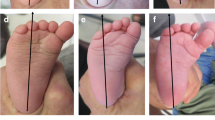Abstract
A total of 484 premature children and a control group of 114 healthy term children underwent orthopaedic follow-up from birth to 5 years of age. At birth, metatarsus adductus was found to be more frequent in twins than in single infants (41% vs 16%; P<0.01), but occurred with equal frequency in single preterm and term infants (16% vs 12%). By 5 years of age, metatarsus adductus had resolved in all the term but only in 81% of the preterm children (P<0.05). In the preterm and term groups, knee axis (mean intermalleolar distance 22.0 mm vs 20.1 mm), tibial torsion (mean angle-1.2° vs +0.6°) and angle of gait (mean angle +1.5° vs +0.7°) at 5 years were statistically insignificant. Hip function at 5 years was similar in normal preterm and term children but significantly decreased in preterm children with cerebral palsy, more so with regard to abduction (56° vs 39°, P<0.05) and extension (22° vs 8°, P<0.01). The difference between the sexes was insignificant in both the preterm and term groups.
Similar content being viewed by others
Abbreviations
- MA:
-
metatarsus adducts
- CP:
-
cerebral palsy
References
Bleck EE (1982) Developmental orthopaedics. III. Toddlers. Dev Med Child Neurol 24:533–555
Bleck EE (1983) Metatarsus adductus: classification and relationship to outcomes of treatment. J Pediatr Orthop 3:2–9
Bunch W (1977) Origin and mechanism of postnatal deformities. Pediatr Clin North Am 24:679–684
Diethelm M, Largo RH (1986) Prospektive Studie über die Tätigkeit des praktizierenden Kinderarztes. Helv Paediatr Acta 41 [Suppl 51]: 29–52
Giacobbi D, Caste R (1982) Fréquence des anomalies pes pieds à la naissance: leur importance pronostique. Ann Pédiatr (Paris) 29:307–309
Hall JG (1985) In utero movement and use of limbs are necessary for normal growth: a study of individuals with arthrogryposis. Prog Clin Biol Res 200:155–162
Katz JF (1982) Behavior of internal tibial torsion in infancy. Mt Sinai J Med (NY) 49:7–12
Kinzinger H (1977) Les vices de torsion des membres inférieures. Acta Orthop Belg 43:379–415
Largo RH, Wälli R, Duc G, Fanconi A, Prader A (1980) Evaluation of perinatal growth. Helv Paediatr Acta 35:419–436
McDade W (1977) Bow legs and knock knees. Pediatr Clin North Am 24:825–839
Ponseti IV, Becker JR (1966) Congenital metatarsus adductus: the results of treatment. J Bone Joint Surg 48:702–711
Prechtl HFR (1980) The optimality concept. Early Hum Dev 4: 201–205
Prechtl HFR, Beintema DJ (1964) The neurological examination of the fullterm newborn infant. Clinics in developmental medicine, no. 12. Spastics Society with Heinemann, London
Salenius P, Vankka E (1975) Development of the tibiofemoral angle in children. J Bone Joint Surg [A] 57:259–261
Silver CM (1978) The treatment of metatarsus adductus deformity in childhood. R I Med J 61:380–382
Staheli LT (1977) Torsional deformity. Pediatr Clin North Am 24:799–811
Taussig G, Pilliard D (1984) Le metatarsus varus congénital. Ann Pediatr (Paris) 31:409–415
Touwen B (1972) Neurological examination of the child with minor neurological dysfunction. Clinics in developmental medicine, no. 38. Spastics International Publications, Heinemann, London; Lippincott, Philadelphia
Vaukka E, Salenius P (1982) Spontaneous correction of severe tibiofemoral deformity in growing children. Acta Orthop Scand 53:567–570
Wynne-Davies R, Littlejohn A, Gormley J (1982) Aetiology and interrelationship of some common skeletal deformities. J Med Genet 19:321–328
Author information
Authors and Affiliations
Additional information
This study was supported by the Swiss National Foundation (No. 3988-1.84) and La Fondation Suisse pour l'Encouragement de la Recherche Scientifique sur l'Arriération Mentale
Rights and permissions
About this article
Cite this article
Hunziker, U.A., Largo, R.H. & Duc, G. Neonatal metatarsus adductus, joint mobility, axis and rotation of the lower extremity in preterm and term children 0–5 years of age. Eur J Pediatr 148, 19–23 (1988). https://doi.org/10.1007/BF00441806
Received:
Accepted:
Issue Date:
DOI: https://doi.org/10.1007/BF00441806




